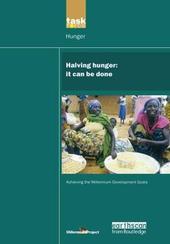
|
Halving Hunger: It Can be Done
Paperback
Main Details
| Title |
Halving Hunger: It Can be Done
|
| Authors and Contributors |
By (author) UN Millennium Project Task Force on Hunger
|
| Series | UN Millennium Development Library |
|---|
| Physical Properties |
| Format:Paperback | | Pages:272 | | Dimensions(mm): Height 253,Width 177 |
|
| Category/Genre | Development economics |
|---|
| ISBN/Barcode |
9781844072200
|
| Classifications | Dewey:338.19 |
|---|
| Audience | | Undergraduate | | Postgraduate, Research & Scholarly | | Professional & Vocational | |
|---|
| Illustrations |
Maps, figures, tables, boxes, index
|
|
Publishing Details |
| Publisher |
Taylor & Francis Ltd
|
| Imprint |
Earthscan Ltd
|
| Publication Date |
1 June 2005 |
| Publication Country |
United Kingdom
|
Description
The Millennium Development Goals, adopted at the UN Millennium Summit in 2000, are the world's targets for dramatically reducing extreme poverty in its many dimensions by 2015i? income poverty, hunger, disease, exclusion, lack of infrastructure and shelteri? while promoting gender equality, education, health and environmental sustainability. These bold goals can be met in all parts of the world if nations follow through on their commitments to work together to meet them. Achieving the Millennium Development Goals offers the prospect of a more secure, just, and prosperous world for all. The UN Millennium Project was commissioned by United Nations Secretary-General Kofi Annan to develop a practical plan of action to meet the Millennium Development Goals. As an independent advisory body directed by Professor Jeffrey D. Sachs, the UN Millennium Project submitted its recommendations to the UN Secretary General in January 2005. i? The core of the UN Millennium Project's work has been carried out by 10 thematic Task Forces comprising more than 250 experts from around the world, including scientists, development practitioners, parliamentarians, policymakers, and representatives from civil society, UN agencies, the World Bank, the IMF, and the private sector. This report lays out the recommendations of the UN Millennium Project Task Force on Hunger in seven major categories: political action; national policy reforms; increased agricultural productivity for food insecure farmers; improved nutrition for the chronically hungry; productive safety nets for the acutely hungry; improved rural incomes and markets; and restoration and conservation of natural resources essential for food security. The task force strongly endorses the Secretary General's call for a 21st Century African Green Revolution. These bold yet practical approaches will enable countries in every region of the world to halve world hunger by 2015.
Author Biography
The Millennium Project was commissioned by the UN Secretary-General and supported by the UN Development group, which is chaired by the Administrator of the United Nations Development Programme. The report is an independent publication that reflects the views of the members of the Task Force on Hunger, who contributed in their personal capacity.
Reviews"The first chapter of this volume based on the work of the UN Millennium Project focuses on the definition of hunger: food and nutritional insecurity; it also explores the reasons for this insecurity, including food availability, socioeconomic and political access and inequalities, sanitation and health facilities, agricultural productivity, environmental factors, conflict, and natural disasters. The following two chapters examine the regions of the world (South and East Asia, North and Sub-Saharan Africa, Latin America and the Caribbean, and the Middle East) where the majority of undernourished people (as evidenced by dietary intake and underweight children) live, and the strategy that the Millennium Project's task force on Hunger proposes for addressing the problems of hunger. The details of this strategy, which include global, national, and community interventions, are outlined in seven recommendations, discussed sequentially in chapters 4 through 10. The final chapter discusses the implementation of these recommendations. This books is a valuable resource of recent information on global hunger, with many tables, maps, fact boxes and figures as well as an appendix on underweight prevalence by subregion and an extensive bibliography. Summing Up: Recommended. Graduate students, faculty, professionals."--E. P. Renne, University of Michigan in CHOICE
|